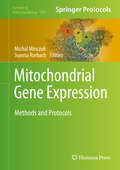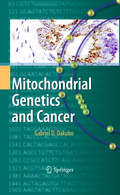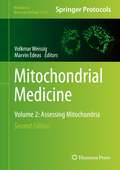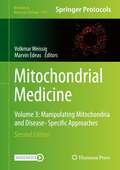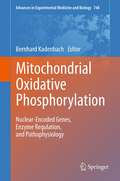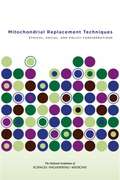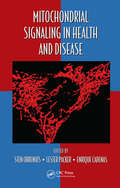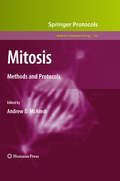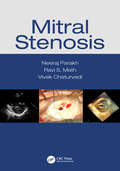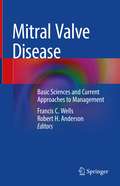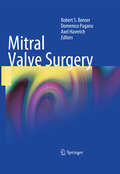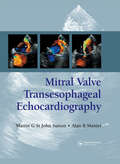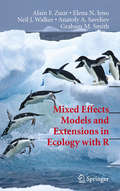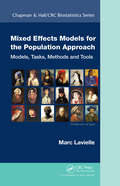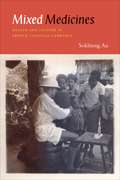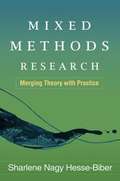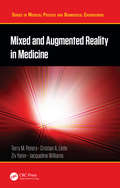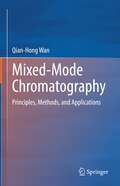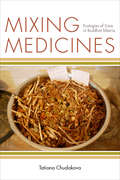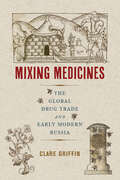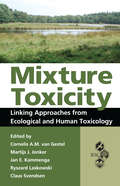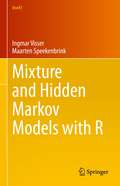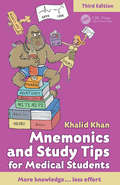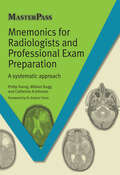- Table View
- List View
Mitochondrial Gene Expression: Methods and Protocols (Methods in Molecular Biology #2192)
by Joanna Rorbach Michal MinczukThis volume details the most recent advancements in the field of mitochondrial gene expression. Chapters guide readers through methods and protocols on mtDNA replication, transcription, and translation to membrane insertion of the mtDNA-encoded protein products. Written in the highly successful Methods in Molecular Biology series format, chapters include introductions to their respective topics, lists of the necessary materials and reagents, step-by-step, readily reproducible laboratory protocols, and tips on troubleshooting and avoiding known pitfalls. Authoritative and cutting-edge, Mitochondrial Gene Expression: Methods and Protocols aims to provide complementary approaches and practical guidelines. Chapter 7 is available Open Access under a Creative Commons Attribution 4.0 International License via link.springer.com.
Mitochondrial Genetics and Cancer
by Gabriel D. DakuboThe pivotal role of mitochondrial functions in carcinogenesis is quite well established. However, the critical role of mitochondrial genome alterations to cancer development is muted in traditional textbooks. Recent scientific efforts have provided unequivocal evidence for mitochondrial genome mutations and content changes in cancer development, progression, and therapy. This pioneering book is a unique compilation of mitochondrial genome alterations in cancer. While primarily focused on the emerging role of mitochondrial genome changes, bioenergetics and signaling pathways, attention is also given to the metabolic transformations of the cancer cell, as well as the established altered cell death processes that underlie cancer evolution and treatment resistance.
Mitochondrial Medicine: Volume 2: Assessing Mitochondria (Methods in Molecular Biology #2276)
by Volkmar Weissig Marvin EdeasThis second edition offers 88 chapters divided among three volumes providing the most comprehensive source of know-how in the wide-ranging field of Mitochondrial Medicine. Volume II guides readers through chapters on mitochondrial dysfunction, functional’ mitochondria, mitochondrial retrograde, mitochondrial dNTP pool quantification, mitochondrial ADP-ribosylation, blue-native gel approach, 3D optical cryo-imaging method, mitochondrial ATP and ROS production, protocol for untargeted metabolomic analysis, and methods for analysis of nitrotyrosine-containing proteins. Written in the highly successful Methods in Molecular Biology series format, chapters include introductions to their respective topics, application details for both the expert and non-expert reader, and tips on troubleshooting and avoiding known pitfalls. Authoritative and accessible, Mitochondrial Medicine, Second Edition, Volume 2: Assessing Mitochondria aims to be a comprehensive source of know-how in the wide-ranging field of Mitochondrial Medicine.
Mitochondrial Medicine: Volume 3: Manipulating Mitochondria and Disease- Specific Approaches (Methods in Molecular Biology #2277)
by Volkmar Weissig Marvin EdeasThis second edition offers 88 chapters divided among three volumes providing the most comprehensive source of know-how in the wide-ranging field of Mitochondrial Medicine. Volume III guides readers through chapters on intercellular mitochondrial transfer, Cytoplasmic transfer methods, Ndufs4 knockout mouse, in vivo assessment of mitochondrial oxygen consumption, mitochondrial network analysis by imaging, mitochondrial respiration in platelets, Heterologous Inferential Analysis (HIA), bioenergetic profiling, integrative methods for studying cardiac energetics, and isolation and deep sequencing of mitochondrial DNA.Written in the highly successful Methods in Molecular Biology series format, chapters include introductions to their respective topics, application details for both the expert and non-expert reader, and tips on troubleshooting and avoiding known pitfalls. Authoritative and accessible, Mitochondrial Medicine, Second Edition, Volume 3: Manipulating Mitochondria and Disease- Specific Approaches aims to be a comprehensive source of know-how in the wide-ranging field of Mitochondrial Medicine.
Mitochondrial Oxidative Phosphorylation
by Bernhard KadenbachThis book will describe the nuclear encoded genes and their expressed proteins of mitochondrial oxidative phosphorylation. Most of these genes occur in eukaryotic cells, but not in bacteria or archaea. The main function of mitochondria, the synthesis of ATP, is performed at subunits of proton pumps (complexes I, III, IV and V), which are encoded on mitochondrial DNA. The nuclear encoded subunits have mostly a regulatory function. However, the specific physiological functions of the nuclear encoded subunits of complexes I, III, IV, and V are mostly unknown. New data indicates that they are essential for life of higher organisms, which is characterized by an adult life without cell division (postmeiotic stage) in most tissues, after the juvenile growth. For complex IV (cytochrome c oxidase) some of these subunits occur in tissue-specific (subunits IV, VIa, VIb, VIIa, VIII), developmental-specific (subunits IV, VIa, and VIIa) as well as species-specific isoforms. Defective genes of some subunits were shown to induce mitochondrial diseases. Mitochondrial genes and human diseases will also be covered.
Mitochondrial Replacement Techniques: Ethical, Social, and Policy Considerations
by Engineering Medicine National Academies of SciencesMitochondrial replacement techniques (MRTs) are designed to prevent the transmission of mitochondrial DNA (mtDNA) diseases from mother to child. While MRTs, if effective, could satisfy a desire of women seeking to have a genetically related child without the risk of passing on mtDNA disease, the technique raises significant ethical and social issues. It would create offspring who have genetic material from two women, something never sanctioned in humans, and would create mitochondrial changes that could be heritable (in female offspring), and therefore passed on in perpetuity. The manipulation would be performed on eggs or embryos, would affect every cell of the resulting individual, and once carried out this genetic manipulation is not reversible. Mitochondrial Replacement Techniques considers the implications of manipulating mitochondrial content both in children born to women as a result of participating in these studies and in descendants of any female offspring. This study examines the ethical and social issues related to MRTs, outlines principles that would provide a framework and foundation for oversight of MRTs, and develops recommendations to inform the Food and Drug Administration’s consideration of investigational new drug applications.
Mitochondrial Signaling in Health and Disease (Oxidative Stress and Disease)
by Enrique Cadenas Lester Packer Sten OrreniusMitochondria have traditionally been associated with metabolic functions; however recent research has uncovered a central role for these organelles in cell signaling, cell survival, and cell death. Mitochondrial dysfunction is a factor in a myriad of pathophysiological conditions, including age-related neurodegenerative disorders, cancer, metabolic
Mitosis
by Andrew D. McainshWith the advent of modern methodology, the phenomenal complexity of the protein components and regulatory steps involved in mitosis has become approachable. In Mitosis: Methods and Protocols, experts in the field provide an up-to-date collection of methods and approaches that are used to investigate the mechanism of mitosis at the molecular level. Ideal for both experienced and novice scientists, the volume includes step-by-step methods covering inactivation of genes of interest, depletion of proteins of interest, biochemical and microscope-based techniques, and procedures to monitor and measure key mitotic processes. Written in the highly successful Methods in Molecular BiologyTM series format, chapters include brief introductions to the respective topics, lists of the necessary materials and reagents, readily reproducible laboratory protocols, and notes on troubleshooting and avoiding known pitfalls. Comprehensive and authoritative, Mitosis: Methods and Protocols combines imaging, biochemical, and genetic methodologies in order to best guide researchers in their attempts to better understand the crucial processes of mitotic regulation.
Mitral Stenosis
by Neeraj Parakh Ravi S Math Vivek ChaturvediComprehensive book on mitral stenosis not only compiles the existing published knowledge and literature about mitral stenosis in a succinct manner but also has input from experts having years of experience in this field. It will serve as an authentic reference and a ready reckoner for cardiology fellows, practicing cardiologists, academics and researchers
Mitral Valve Disease: Basic Sciences and Current Approaches to Management
by Robert H. Anderson Francis C. WellsThis book provides a comprehensive review of the basic science of the mitral valve needed to begin to comprehend both normal and the failing valve. This knowledge is infrequently discussed in the clinical arena, with a rush towards definition of lesions based on limited analysis. It provides a ready single source of the most important basic science subjects pertaining to the valve, and the pathologies found therein, and thus a more complete understanding of the factors that result in dysfunction may be appreciated. Mitral Valve Disease: Basic Sciences and Current Approaches to Management includes chapters on embryology and anatomy, including details of structural, comparative and functional features. Since the valve is completely influenced by genetics and molecular biology, subjects rarely if ever addressed in the clinical arena, these topics receive in-depth attention. Coverage concludes with lengthy discussions of the importance of multi-disciplinary work, along with the importance of the electrophysiological disturbances encountered in some groups of these patients. It therefore is an essential and up-to-date resource for the practicing and trainee cardiac surgeon and any researcher working within this topic.
Mitral Valve Surgery
by Robert S. Bonser Domenico Pagano Axel HaverichPart of the Monographs in Cardiac Surgery Series - Introducing 'basic science into the cardiac operating room'. Fast systematic review of small areas of cardiac surgery including up-to-date information. This will allow more rapid publication than the alternative cardiac surgery 'tomes'. This entry into the series will provide readers with a complete review of the current understanding in mitral valve surgery and include extensive details on the diagnosis and surgical management of patients with mitral valve disease.
Mitral Valve Transesophageal Echocardiography
by Martin G. St. John Sutton Alan R. ManietThe only book available on transesophageal echocardiography of the mitral valve, this impressive and highly illustrated text provides a concise yet in-depth analysis of the mitral valve from an experience of over 10,000 transesophageal echocardiograms performed by the authors.A starting point or 'how-to' reference for studying the mitral valve
Mixed Effects Models and Extensions in Ecology with R
by Neil Walker Elena N. Ieno Graham M. Smith Anatoly A. Saveliev Alain ZuurThis book discusses advanced statistical methods that can be used to analyse ecological data. Most environmental collected data are measured repeatedly over time, or space and this requires the use of GLMM or GAMM methods. The book starts by revising regression, additive modelling, GAM and GLM, and then discusses dealing with spatial or temporal dependencies and nested data.
Mixed Effects Models for the Population Approach: Models, Tasks, Methods and Tools (Chapman & Hall/CRC Biostatistics Series)
by Marc LavielleWide-Ranging Coverage of Parametric Modeling in Linear and Nonlinear Mixed Effects ModelsMixed Effects Models for the Population Approach: Models, Tasks, Methods and Tools presents a rigorous framework for describing, implementing, and using mixed effects models. With these models, readers can perform parameter estimation and modeling across a whol
Mixed Medicines: Health and Culture in French Colonial Cambodia
by Sokhieng AuDuring the first half of the twentieth century, representatives of the French colonial health services actively strove to expand the practice of Western medicine in the frontier colony of Cambodia. But as the French physicians ventured beyond their colonial enclaves, they found themselves negotiating with the plurality of Cambodian cultural practices relating to health and disease. These negotiations were marked by some success, a great deal of misunderstanding, and much failure. Bringing together colorful historical vignettes, social and anthropological theory, and quantitative analyses, "Mixed Medicines" examines these interactions between the Khmer, Cham, and Vietnamese of Cambodia and the French, documenting the differences in their understandings of medicine and revealing the unexpected transformations that occurred during this periodOCofor both the French and the indigenous population.
Mixed Methods Research
by Sharlene Hesse-BiberThis accessibly written book is ideal for use in graduate courses or by practicing researchers and evaluators. The author puts the research problem at center stage, showing how mixed methods designs can fruitfully address different types of research questions. She illustrates the discussion with examples of mixed methods studies from a variety of disciplines and qualitative approaches (interpretative, feminist, and postmodern). The text demonstrates how to navigate ethical issues; gather, analyze, and interpret data; and write up the results, including an in-depth example with step-by-step commentary. Special features include "researcher standpoint" reflections from leading scholars and practical strategies to help users develop their own research perspectives. Every chapter concludes with a glossary, discussion questions, and useful Web resources.
Mixed Models
by Eugene DemidenkoPraise for the First Edition "This book will serve to greatly complement the growing number of texts dealing with mixed models, and I highly recommend including it in one's personal library."--Journal of the American Statistical Association Mixed modeling is a crucial area of statistics, enabling the analysis of clustered and longitudinal data. Mixed Models: Theory and Applications with R, Second Edition fills a gap in existing literature between mathematical and applied statistical books by presenting a powerful examination of mixed model theory and application with special attention given to the implementation in R.The new edition provides in-depth mathematical coverage of mixed models' statistical properties and numerical algorithms, as well as nontraditional applications, such as regrowth curves, shapes, and images. The book features the latest topics in statistics including modeling of complex clustered or longitudinal data, modeling data with multiple sources of variation, modeling biological variety and heterogeneity, Healthy Akaike Information Criterion (HAIC), parameter multidimensionality, and statistics of image processing.Mixed Models: Theory and Applications with R, Second Edition features unique applications of mixed model methodology, as well as:Comprehensive theoretical discussions illustrated by examples and figuresOver 300 exercises, end-of-section problems, updated data sets, and R subroutinesProblems and extended projects requiring simulations in R intended to reinforce materialSummaries of major results and general points of discussion at the end of each chapterOpen problems in mixed modeling methodology, which can be used as the basis for research or PhD dissertationsIdeal for graduate-level courses in mixed statistical modeling, the book is also an excellent reference for professionals in a range of fields, including cancer research, computer science, and engineering.
Mixed and Augmented Reality in Medicine (Series in Medical Physics and Biomedical Engineering)
by Ziv Yaniv Jacqueline Williams Terry M. Peters Cristian A. LinteAugmented reality (AR) is transforming how we work, learn, play and connect with the world, and is now being introduced to the field of medicine, where it is revolutionising healthcare as pioneering virtual elements are being added to real images to provide a more compelling and intuitive view during procedures. This book, which had its beginnings at the AE-CAI: Augmented Environments for Computer-Assisted Interventions MICCAI Workshop in Munich in 2015, is the first to review the area of mixed and augmented reality in medicine. Covering a range of examples of the use of AR in medicine, it explores its relevance to minimally-invasive interventions, how it can improve the accuracy of a procedure and reduce procedure time, and how it may be employed to reduce radiation risks. It also discusses how AR can be an effective tool in the education of physicians, medical students, nurses and other health professionals. Features: An ideal practical guide for medical professionals and students looking to understand the implementation, applications, and future of AR Contains the latest developments and technologies in this innovative field Edited by highly respected pioneers in the field, who have been immersed in AR as well as virtual reality and image-guided surgery since their inception, with chapter contributions from subject area specialists working with AR
Mixed-Mode Chromatography: Principles, Methods, and Applications
by Qian-Hong WanThe book is about the technology and application of Mixed-mode chromatography (MMC). Unlike conventional single-mode HPLC, which resolves the analytes primarily based on their ionic or hydrophobic properties, MMC employs multifunctional stationary phases to exploit at least two modes of interactions (i.e., ionic and hydrophobic) with the analytes and as such often provides resolution that far exceeds that observed with a single-mode process. Over the past two decades, MMC has developed into an important analytical and purification tool in a number of applications in pharmaceutical and biotechnology industries. The technique has been used widely for the analyses of nucleic acids, amino acids, peptides, proteins, glycoproteins, carbohydrates, antibiotics, vaccines, and other products. The purpose of this book is to present a comprehensive survey of mixed-mode chromatography and is intended as a reference guide for graduate students and experienced scientists in pharmaceutical and biotechnology disciplines wishing to gain a deep understanding of this continuously evolving technology.
Mixing Medicines: Ecologies of Care in Buddhist Siberia (Thinking from Elsewhere)
by Tatiana ChudakovaTraditional medicine enjoys widespread appeal in today’s Russia, an appeal that has often been framed either as a holdover from pre-Soviet times or as the symptom of capitalist growing pains and vanishing Soviet modes of life. Mixing Medicines seeks to reconsider these logics of emptiness and replenishment. Set in Buryatia, a semi-autonomous indigenous republic in Southeastern Siberia, the book offers an ethnography of the institutionalization of Tibetan medicine, a botanically-based therapeutic practice framed as at once foreign, international, and local to Russia’s Buddhist regions.By highlighting the cosmopolitan nature of Tibetan medicine and the culturally specific origins of biomedicine, the book shows how people in Buryatia trouble entrenched center-periphery models, complicating narratives about isolation and political marginality. Chudakova argues that a therapeutic life mediated through the practices of traditional medicines is not a last-resort response to sociopolitical abandonment but depends on a densely collective mingling of human and non-human worlds that produces new senses of rootedness, while reshaping regional and national conversations about care, history, and belonging.
Mixing Medicines: The Global Drug Trade and Early Modern Russia (Intoxicating Histories)
by Clare GriffinEarly modern Russians preferred one method of treating the sick above all others: prescribing drugs. The Moscow court sourced pharmaceuticals from Asia, Africa, Western Europe, and the Americas, in addition to its own sprawling empire, to heal its ailing tsars.Mixing Medicines explores the dynamic and complex world of early modern Russian medical drugs, from its enthusiasm for newly imported American botanicals to its disgust at Western European medicines made from human corpses. Clare Griffin draws from detailed apothecary records to shed light on the early modern Russian Empire’s role in the global trade in medical drugs. Chapters follow the trade and use of medical ingredients through networks that linked Moscow to Western Europe, Asia, and the Americas; the transformation of natural objects, such as botanicals and chemicals, into medicines; the documentation and translation of medical knowledge; and Western European influence on Russian medical practices. Looking beyond practitioners, texts, and ideas to consider how materials of medicine were used by one of the early modern world’s major empires provides a novel account of the global history of early modern medicine.Mixing Medicines offers unique insight into how the dramatic reshaping of global trade touched the day-to-day lives of the people living in early modern Russia.
Mixture Toxicity: Linking Approaches from Ecological and Human Toxicology
by Jerome Klosowski Andreas T. WolfIn the last decade and a half, great progress has been made in the development of concepts and models for mixture toxicity, both in human and environmental toxicology. However, due to their different protection goals, developments have often progressed in parallel but with little integration. Arguably the first book to clearly link ecotoxicology an
Mixture and Hidden Markov Models with R (Use R!)
by Ingmar Visser Maarten SpeekenbrinkThis book discusses mixture and hidden Markov models for modeling behavioral data. Mixture and hidden Markov models are statistical models which are useful when an observed system occupies a number of distinct “regimes” or unobserved (hidden) states. These models are widely used in a variety of fields, including artificial intelligence, biology, finance, and psychology. Hidden Markov models can be viewed as an extension of mixture models, to model transitions between states over time. Covering both mixture and hidden Markov models in a single book allows main concepts and issues to be introduced in the relatively simpler context of mixture models. After a thorough treatment of the theory and practice of mixture modeling, the conceptual leap towards hidden Markov models is relatively straightforward. This book provides many practical examples illustrating the wide variety of uses of the models. These examples are drawn from our own work in psychology, as well as other areas such as financial time series and climate data. Most examples illustrate the use of the authors’ depmixS4 package, which provides a flexible framework to construct and estimate mixture and hidden Markov models. All examples are fully reproducible and the accompanying hmmR package provides all the datasets used, as well as additional functionality. This book is suitable for advanced students and researchers with an applied background.
Mnemonics and Study Tips for Medical Students: Two Zebras Borrowed My Car!
by Khalid KhanThis fun, pocket-sized and practical guide is jam-packed with helpful tips on how to remember those all-important medical facts crucial to exam success and invaluable throughout the medical career. New to this edition are 35 additional mnemonics, more information on prescribing, a section on the use of 'smart drugs' when studying, additional SWOT boxes and an improved interior layout with more colour for added clarity. The third edition remains an essential read for every medical student.
Mnemonics for Radiologists and FRCR 2B Viva Preparation: A Systematic Approach
by Phillip Yoong William Bugg Catherine A. JohnsonRevising for the final FRCR examination is a challenging task. The candidate has to balance their revision time between image interpretation practice, learning facts and refining presentation skills. Whilst it is better to gain an understanding of the underlying mechanisms that result in a radiological abnormality, it is an unavoidable truth that some things just have to be rote learned. This revision guide demonstrates a proven mechanism for organising thoughts, directing revision towards the more important diagnoses and providing clarity when confronted with the mountain of information expected to retained and recalled during the FRCR viva exam. Mnemonics typically uses word-based cues to enhance memory, reduce cognitive load and aid learning. This guide relies on acronyms and acrostics - proven to be highly effective for rote learning and focused revision. FRCR examination candidates will appreciate the unified structure throughout, with extensive use of sample images followed by sets of differential diagnoses and mnemonic listings. For each stem of the mnemonic, the main radiological findings and useful distinguishing features are listed and a model answer is given. A short discussion of the main diagnoses follows, increasing comprehension and aiding examination confidence.
